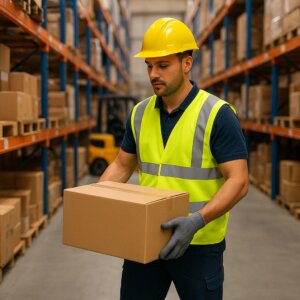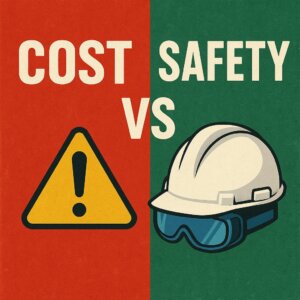The chemical industry is one of the most essential sectors in the global economy, responsible for producing everything from medicines and cleaning products to plastics and fuels. However, working in this field comes with significant risks. Exposure to harmful chemicals, extreme temperatures, and potential accidents demands a robust approach to worker safety.
Personal Protective Equipment (PPE) plays a vital role in minimizing these risks, ensuring that workers remain protected from both short-term injuries and long-term health problems. In this blog, we’ll explore the essential PPE required for the chemical industry, the latest advancements in protective gear, and why safety should always come first.
1. Chemical-Resistant Clothing: Shielding Against Dangerous Substances
In a chemical plant or laboratory, workers are often exposed to corrosive, toxic, or flammable substances. Chemical-resistant clothing is a critical layer of defense against these hazardous materials. This includes specially designed protective suits, lab coats, and aprons made from durable materials like PVC, neoprene, or Tyvek. These fabrics are resistant to chemical penetration, ensuring that workers are shielded from spills or splashes of harmful liquids.
In 2025, expect to see even more advanced materials that offer increased comfort and flexibility without compromising on protection, making long hours of work more manageable while maintaining safety standards.
2. Protective Gloves: Ensuring Hand Safety from Harsh Chemicals
The hands are one of the most vulnerable parts of the body when working with chemicals, whether handling corrosive substances or operating equipment. Chemical-resistant gloves are a must-have in the industry. These gloves are made from various materials such as nitrile, butyl rubber, or neoprene, depending on the chemicals being handled.
Innovative gloves are now being developed with enhanced grip, increased dexterity, and better tactile sensitivity. For instance, gloves with cut-resistant properties can also be used in environments where sharp tools or materials are present.
3. Safety Goggles and Face Shields: Protecting the Eyes and Face
Chemicals can cause serious eye damage if they come into contact with the eyes, whether through splashes, vapors, or fumes. Safety goggles or face shields are essential PPE for anyone working in environments where there is a risk of eye injury.
Goggles provide a snug, secure fit to prevent chemicals from entering the eyes, while face shields offer broader protection, covering the entire face. Newer models feature anti-fog coatings and adjustable straps, ensuring that workers maintain clear vision while staying comfortable.
4. Respiratory Protection: Breathing Safely in a Toxic Environment
The chemical industry often involves exposure to harmful vapors, gases, and dust. Without proper respiratory protection, workers can develop chronic respiratory conditions, or worse, suffer from immediate poisoning. Respirators or dust masks equipped with the appropriate filters are essential for preventing inhalation of toxic substances.
For those working with volatile chemicals or in confined spaces, powered air-purifying respirators (PAPR) and self-contained breathing apparatus (SCBA) are also crucial. These devices ensure that workers are supplied with clean air, preventing the intake of harmful substances.
5. Protective Footwear: Preventing Chemical Burns and Injury
In the chemical industry, the risk of stepping on sharp objects, exposure to toxic liquids, or even slipping on wet floors is ever-present. Chemical-resistant boots are designed to offer both protection and comfort, featuring waterproof materials, slip-resistant soles, and reinforced toes.
The use of boots with steel-toe protection is particularly important in environments where heavy materials are being transported, or where there is a risk of falling objects. Ensuring the feet are adequately protected reduces the risk of workplace accidents and injuries.
6. Hearing Protection: Safeguarding Against Noise Hazards
Many chemical plants operate machinery that generates high levels of noise. Hearing protection, such as earplugs or earmuffs, is essential to prevent hearing loss in workers exposed to loud environments for prolonged periods. Some new hearing protection devices also come equipped with communication capabilities, allowing workers to stay connected without compromising their hearing.
7. Smart PPE: A New Frontier for Worker Safety
The future of PPE in the chemical industry lies in smart technology. Wearable devices that monitor workers’ health and safety in real-time are on the rise. For example, smart gloves can measure the amount of exposure to chemicals and notify workers when it’s time to take a break or use additional protective measures. Similarly, wearable sensors embedded in protective suits can detect the presence of harmful gases or chemicals, instantly alerting the wearer.
These innovations make it easier to protect workers and create a safer work environment in real time, without relying solely on manual monitoring.
Conclusion: PPE as a Cornerstone of Chemical Industry Safety
In the chemical industry, safety should always be the top priority. Whether handling dangerous chemicals, working with hazardous machinery, or dealing with extreme temperatures, proper PPE is essential to minimizing risks and protecting workers from harm. As the industry evolves, so too will the technology behind PPE, making it more comfortable, efficient, and effective.
At CHEAMYPPE, we provide high-quality, durable PPE solutions tailored to the needs of the chemical industry. Our products are designed to ensure maximum protection and comfort, so your workers can focus on their tasks with peace of mind. For more information on our chemical industry PPE products, visit www.cheamyppe.com.








